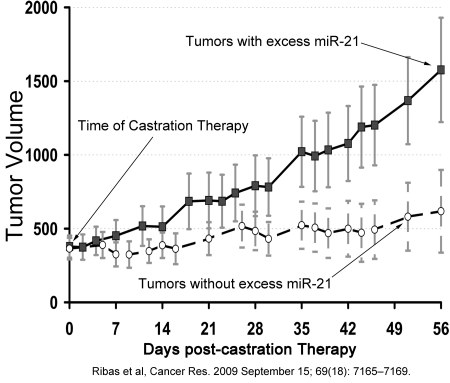


Posted December 5, 2013
Shawn Lupold, Ph.D., Johns Hopkins University
 MicroRNAs (miR) are a new and relatively understudied class of genes that are known as non-coding because they aren't used by cells for the direct synthesis of proteins. Since only about 1.5% of the human genome encodes for proteins, there is a large expanse of understudied non-coding genetic elements, including microRNAs, that could hold a wealth of information about the factors that influence prostate cancer development and progression. Dr. Shawn Lupold, a FY07 PCRP New Investigator Award recipient, and his research team at the Johns Hopkins University have undertaken this challenge to focus on certain miRNAs to determine if they could cause prostate cancers to develop into aggressive phenotypes such as castration-resistant prostate cancer, which continues growing even after deprivation from androgen hormones. They found that one such miRNA, miR-21, was capable of driving tumors to grow after castration.
MicroRNAs (miR) are a new and relatively understudied class of genes that are known as non-coding because they aren't used by cells for the direct synthesis of proteins. Since only about 1.5% of the human genome encodes for proteins, there is a large expanse of understudied non-coding genetic elements, including microRNAs, that could hold a wealth of information about the factors that influence prostate cancer development and progression. Dr. Shawn Lupold, a FY07 PCRP New Investigator Award recipient, and his research team at the Johns Hopkins University have undertaken this challenge to focus on certain miRNAs to determine if they could cause prostate cancers to develop into aggressive phenotypes such as castration-resistant prostate cancer, which continues growing even after deprivation from androgen hormones. They found that one such miRNA, miR-21, was capable of driving tumors to grow after castration.
miR-21 was one of 15 miRNAs that were discovered in prostate cancer cells by analyzing the changes in miRNA expression levels after treatment with androgens using a high-throughput microarray assay. The discovery that the transcription of this one specific miRNA was directly induced by the activated androgen receptor (AR) was particularly important because the AR remains active in many cancers, even after castration therapy. Dr. Lupold's team also showed that over-expression of miR-21 in castration-sensitive prostate cancer cells and tumors caused faster cell and tumor growth and, even more importantly, elevated expression of miR-21 alone was found to be sufficient to cause these castration-sensitive tumors to become castration-resistant.
Excitingly, miR-21 shows promise for clinical application, as preliminary studies from several groups suggest that miR-21 levels are higher in the tissue or serum of some patients with more aggressive prostate cancer. Other miRNAs have also been observed to be over- or under-expressed in the tissues and serum of men with more aggressive prostate cancer. While larger studies are still needed to validate the use of miRNA expression in distinguishing aggressive from indolent prostate cancer, Dr. Lupold's work shows that these non-coding elements can contribute to aggressive prostate cancer biology, which suggests that their detection may be useful for improving prognostics for managing prostate cancer. Moreover, these non-coding RNAs may be targets for cancer therapeutics.

References:
1. Ribas J, Ni X, Haffner M, Wentzel EA, Salmasi1 AH, Chowdhury WE, Kudrolli TA, Yegnasubramanian A, Luo J, Rodriguez T, Mendell JT, Lupold SE. miR-21: An androgen receptor regulated microRNA which promotes hormone dependent and independent prostate cancer growth. Cancer Research. 69(18): 7165-9, 2009. PMCID: PMC2861586.
2. Ribas J and Lupold SE. The transcriptional regulation of miR-21, its multiple transcripts, and their implication in prostate cancer. Cell Cycle; 9(5), 923-9, 2010. PMCID: PMC3462654
3. Ribas J, Ni X, Castanares M, Liu M, Rodriguez R, Mendell JT, and Lupold SE. A novel source for miR-21 expression through the alternative polyadenylation of VMP1 gene transcripts. Nucleic Acids Res. 2012 Aug 1;40(14):6821-33. PMCID: PMC3413119














